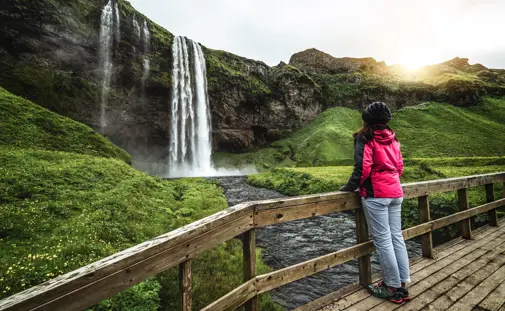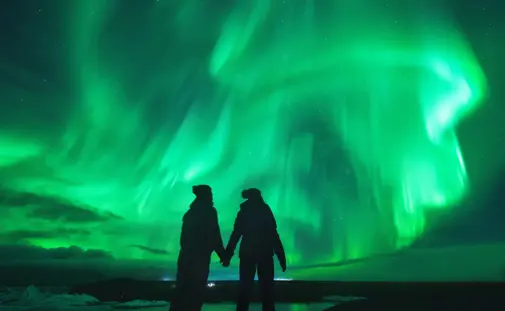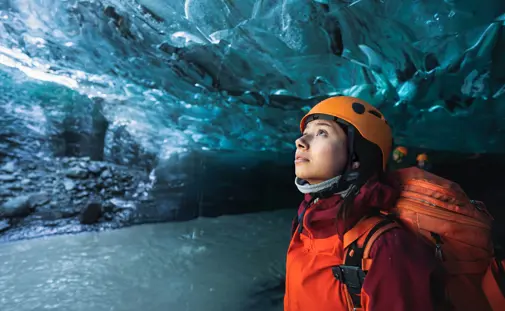Explore Sólheimajökull Glacier
Sólheimajökull Glacier is one of Iceland’s most accessible natural wonders and located on the southern coast of Iceland. Like many other Icelandic glaciers, Sólheimajökull itself is a tongue of the larger Mýrdalsjökull glacier and has become a must-visit destination for adventurers visiting Iceland.
Learn everything you need to know about Sólheimajökull Glacier, including its history, geology, activities, and nearby attractions.
Quick Facts about Sólheimajökull Glacier
- Location: South Iceland, approximately 158 km (98 miles) from Reykjavík.
- Type: Glacier tongue extending from the Mýrdalsjökull ice cap.
- Status: Rapidly shrinking 'climate glacier'
- Size: Approximately 11 km (6.8 miles) long and 1-2 km (0.6-1.2 miles) wide.
- Closest Town: Vík (26 km, 16 miles away).
History and Geology of Sólheimajökull
Sólheimajökull Glacier is more than just a natural wonder; it is a fascinating geological entity that encapsulates the dynamic interplay of volcanic activity, glacial processes, and climate change over thousands of years. Its history and structure provide valuable insights into the natural forces that have shaped Iceland’s unique landscape.
The glacier is a so called 'Climate Glacier' - A glacier responding quickly to climate change and could disappear within decades.
Geological Origins
Sólheimajökull is a glacier tongue extending from the larger Mýrdalsjökull ice cap, which covers an area of approximately 600 square kilometers (230 square miles) and lies atop the Katla volcanic system. The formation of glaciers like Sólheimajökull began during the last Ice Age, approximately 2.6 million years ago. During this period, cooler global temperatures led to the accumulation of ice and snow over Iceland's highlands. Over time, the weight of the snow compressed it into dense glacial ice.
The glacier is primarily composed of layers of compacted snow and ice interspersed with volcanic ash from past eruptions of Katla and neighboring volcanoes such as Eyjafjallajökull. These eruptions left distinct layers of ash embedded within the ice, creating a visual record of Iceland’s volcanic history.
Interaction with the Katla Volcanic System
The Katla volcano, located beneath Mýrdalsjökull, is one of Iceland’s most active and powerful volcanoes. It has erupted approximately every 50–100 years over the past millennium, with the most recent significant eruption occurring in 1918. Each eruption causes rapid melting of the glacier above, resulting in jökulhlaups, or glacial outburst floods. These floods carve deep canyons, deposit vast quantities of sediment, and reshape the surrounding landscape.
The interaction between volcanic heat and glacial ice also creates unique formations such as ice caves, subglacial lakes, and hydrothermal vents. The heat from Katla contributes to the basal melting of Sólheimajökull, lubricating its base and accelerating its flow.
Retreat and Climate Change
Sólheimajökull is a striking example of how climate change impacts glaciers. Since the early 20th century, the glacier has been retreating steadily, a process that has accelerated dramatically in recent decades due to rising global temperatures. Between 1930 and 2023, Sólheimajökull has retreated by over 2 kilometers (1.2 miles), with significant ice loss occurring in the past two decades.
Scientific Observations:
- The glacier loses approximately 40 meters (131 feet) in length annually.
- Satellite data reveal a significant thinning of the glacier, with some areas losing up to 15 meters (49 feet) of ice thickness per year.
This retreat has exposed a newly formed lagoon at the glacier’s terminus. The lagoon is filled with meltwater, icebergs, and sediment, creating a dynamic and ever-changing environment.
Composition and Structure
The surface of Sólheimajökull Glacier is a mesmerizing tapestry of blue ice, white ice, and debris-laden ice, each telling a unique story of its formation and evolution. The blue ice, found in the glacier’s deeper layers, owes its striking hue to its compact structure, which lacks air bubbles and reflects light differently. Closer to the surface, white ice dominates, formed as snow compacts over time and retains trapped air bubbles that soften its appearance. The glacier's rugged exterior is further adorned with debris-laden ice, a result of the glacier’s relentless movement collecting volcanic ash, sand, and gravel. These dark streaks and patches give Sólheimajökull its distinctive, weathered character.
As gravity drives the glacier downhill, it creeps forward at a rate of approximately 10 to 30 centimeters (4 to 12 inches) per day. This movement, combined with the uneven terrain below, carves out dramatic crevasses, plunging moulins (vertical shafts), and jagged seracs (ice towers). Together, these features create a breathtakingly rugged landscape that captures the dynamic energy of the glacier.
Sólheimajökull’s Role in Iceland’s Geology
Sólheimajökull Glacier plays a pivotal role in the geological narrative of Iceland. Situated within the South Iceland Seismic Zone, a tectonically active area where the Eurasian and North American plates drift apart, the glacier sits at the intersection of immense geological forces. This strategic location makes Sólheimajökull a hotspot for activity, with earthquakes frequently rumbling beneath its ice due to the constant movements of tectonic plates and volcanic activity from Katla, the powerful volcano it overlies.
The glacier’s surroundings bear the marks of historic lava flows from Katla’s past eruptions, which have dramatically shaped the terrain. Additionally, Sólheimajökull serves as a natural conveyor belt for sediment, carrying vast quantities downstream into the Markarfljót River. Over time, this process has contributed to the creation of Iceland’s iconic black sand plains, a testament to the glacier’s impact on the broader landscape.
Scientific Importance
Sólheimajökull is not only a striking natural wonder but also a critical hub for scientific research. Its rapid retreat and changing structure offer a living laboratory for scientists to monitor the impacts of climate change. Researchers employ advanced tools like GPS and remote sensing technology to track the glacier's shrinking size and thinning ice layers, gathering invaluable data on global warming’s effects.
Beyond its role as a climate indicator, Sólheimajökull is central to understanding glacier-volcano interactions. The interplay between the heat from Katla and the overlying ice provides insights into the dynamics of subglacial environments and their potential hazards. This research is crucial for predicting events such as jökulhlaups, the catastrophic glacial floods that can reshape landscapes and pose risks to nearby communities.
Moreover, Sólheimajökull draws researchers from across the globe as an outdoor laboratory for glaciology and volcanology. Its accessibility and dramatic features make it an ideal setting for studying the forces that continue to shape our planet, solidifying its role as a cornerstone of scientific exploration in Iceland.
The Future of Sólheimajökull
While Sólheimajökull’s retreat highlights the challenges of climate change, it also underscores the glacier’s dynamic nature. Efforts to mitigate the effects of climate change, combined with ongoing research, aim to preserve this extraordinary natural wonder for future generations.
By understanding Sólheimajökull’s history and geology, visitors can appreciate not only its breathtaking beauty but also its vital role in Iceland’s natural and cultural heritage.
How to Get to Sólheimajökull?
Sólheimajökull is easily accessible from Iceland's famous Ring Road (Route 1). From Reykjavík, drive east on Route 1 for approximately 2.5 hours. Then, turn left onto Route 221 (Sólheimajökulsvegur road), following signs for the glacier. Continue your drive for about 4 km (2.5 miles) to reach the Sólheimajökull parking area.
The parking area is free and equipped with basic amenities like restrooms. From the lot, it's a short 10-15 minute walk to the glacier’s edge.
Distance from Key Locations
- Reykjavík: 158 km (98 miles) – 2.5 hours by car.
- Vík: 26 km (16 miles) – 30 minutes by car.
- Skógafoss Waterfall: 11 km (7 miles) – 10 minutes by car.
Activities at Sólheimajökull Glacier
Sólheimajökull Glacier is a dynamic playground for adventurers, nature enthusiasts, and those eager to learn about Iceland's ever-changing landscapes. Its accessibility and striking features make it a popular destination for a range of activities, each offering a unique way to experience this icy wonderland.
Glacier Hiking
A guided hike across Sólheimajökull's icy expanse is a must-do for visitors. With crampons strapped to your boots you'll see shimmering blue ice up close, and depending on the tour you might get to experience deep crevasses formations and ice caves. The hikes, which typically lasts between two to four hours, are usually suitable for all skill levels, making it accessible to both beginners and more seasoned adventurers. Guided tours provide all the necessary equipment, including crampons, helmets and other necessary safety equipment to ensure a safe experience.
Ice Climbing
For thrill-seekers, ice climbing on the glacier’s towering icy walls is usually better kept for more experienced adventurers. Under the guidance of expert instructors, climbers can test their skills as they ascend vertical ice formations, using ice axes and harnesses to navigate the frozen surfaces. These tours, which generally last three to five hours, cater to both beginners and experienced climbers looking to push their limits.
Kayaking and Paddle boarding
For a more tranquil experience, kayaking or paddle boarding on the glacier lagoon that has formed in front of the glacier due to its melting, provides a unique perspective of Sólheimajökull. You'll experience paddling next to floating icebergs on the lagoon along with gorgeous views of the glacier’s edges. These tours, which typically last two to three hours, are perfect for nature lovers and photographers eager to capture the interplay of ice and water. No prior experience is required, and all necessary equipment is provided. An ideal option for anyone seeking a peaceful adventure.
Snowmobiling on Sólheimajökull Glacier
Snowmobiling on Sólheimajökull Glacier is definitely an exciting way to explore Iceland's icy landscapes. This activity let's travelers explore cover more ground and explore a larger area compared to a glacier hike. Tours typically begin with a safety briefing and gear fitting, followed by a guided ride on snowmobiles equipped for rugged conditions.
Visitors can expect to see glacier crevasses, ice formations, and panoramic views of the surrounding Mýrdalsjökull ice cap and South Coast. Most tours last two to three hours and require no prior experience and since riders often share snowmobiles it's a funt choice for couples or families with older children.
Sólheimajökull Dangers
Due to the glaciers easy access many visitors forget the dangers of venturing close to a glacier. Visitors are encouraged to keep a safe distance from the glacier and the lagoon as the ice is unpredictable, with hidden crevasses and unstable surfaces.
When you kayak the lagoon, an activity that should only be done with a guide, keep a safe distance from the icebergs as they sometimes flip over and break causing building sized dangers and large waves, and never leave your kayak to walk on the icebergs.
Major Do Not's:
- Do not walk on the glacier without a guide
- Do not walk on the icebergs in the lagoon
Nearby Attractions
For visitors who plan to stay in the area might want to discover nearby attractions. These are a few not to be missed.
Reynisfjara Black Sand Beach
Distance from Sólheimajökull Glacier: 24 km (15 miles)
Reynisfjara Black Sand Beach is one of Iceland's most famous natural wonders, featuring volcanic black sands, basalt column formations, and the towering Reynisdrangar sea stacks rising dramatically from the ocean. This surreal location is a must-visit for its beauty, especially during sunrise or sunset when the light enhances the contrasting colors.
Reynisdrangar
Distance from Sólheimajökull Glacier: 23 km (14 miles)
The Reynisdrangar sea stacks are a fascinating natural feature near Reynisfjara Beach. According to Icelandic folklore, these towering basalt columns were trolls turned to stone by sunlight. They provide a striking backdrop to the beach, offering great photography opportunities and a glimpse into Iceland's geological history.
Skógafoss Waterfall
Distance from Sólheimajökull Glacier: 13 km (8 miles)
Skógafoss is a breathtaking waterfall that cascades 60 meters (197 feet) from the cliffs of an ancient coastline. Its mist often creates vivid rainbows, making it a photographer's dream. Visitors can also climb the stairs to the viewing platform for a stunning perspective of the falls and the surrounding landscape.
Dyrhólaey
Distance from Sólheimajökull Glacier: 19 km (12 miles)
Dyrhólaey is a stunning promontory offering panoramic views of the coastline, including black sand beaches and the vast Atlantic Ocean. The iconic arch-shaped rock formation and the area’s abundance of puffins during summer months make it a popular destination for both nature enthusiasts and photographers.
Vík í Mýrdal
Distance from Sólheimajökull Glacier: 25 km (16 miles)
The charming village of Vík is known for its picturesque surroundings and proximity to major South Coast attractions. Its iconic red-roofed church, perched on a hill overlooking the village, is a popular spot for stunning views. Vík also offers shops, cafés, and the chance to experience Icelandic hospitality.
Seljalandsfoss Waterfall
Distance from Sólheimajökull Glacier: 29 km (18 miles)
Seljalandsfoss is one of Iceland’s most unique waterfalls, as visitors can walk behind its cascading curtain of water. The 60-meter-high falls are accessible via a well-maintained trail, offering a one-of-a-kind experience for visitors seeking a closer connection to Iceland's natural beauty.
Katla Geopark
Distance from Sólheimajökull Glacier: Located within the region
Katla Geopark encompasses the glacier and surrounding areas, highlighting the dynamic interplay of volcanic and glacial activity. It features dramatic landscapes, including lava fields, craters, and hot springs, making it a paradise for geology enthusiasts and adventurers exploring the South Coast.






